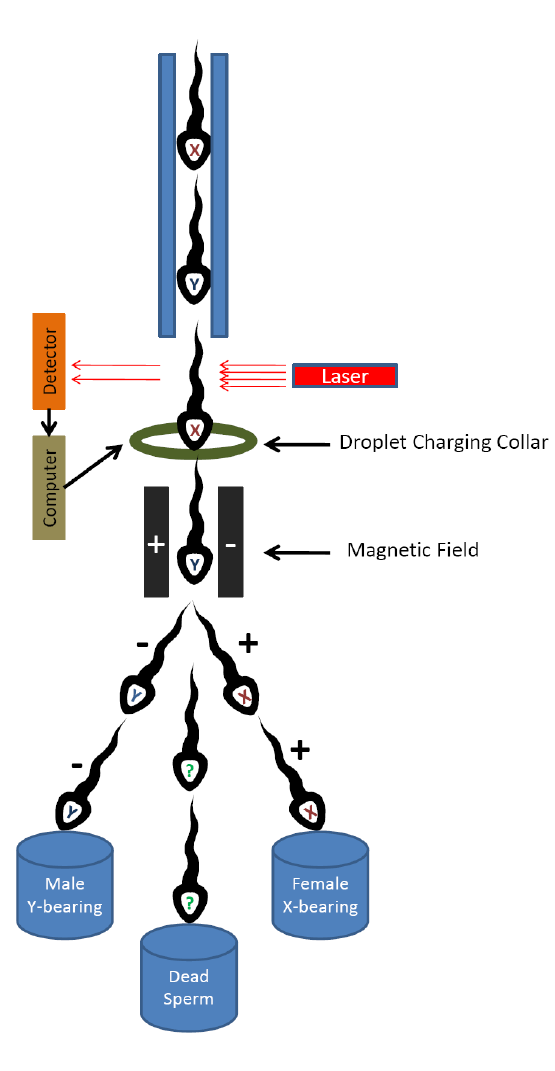Sex-Sorted Semen for Beef Cow-Calf Production
Attempts to shift the gender ratio for a calf crop have been tried several different ways, but the idea of sorting or selecting semen to favor male or female offspring has been researched since the advent of artificial insemination. This is possible because the fertilizing sperm cell determines the gender of the calf. Because of the genetic makeup of the cells, sperm that produce female offspring are referred to as X-bearing sperm, while those that produce male offspring are referred to as Y-bearing sperm.
Sex-Sorting Technology
Several attempts have been made to develop a method that efficiently separates bovine semen into fractions containing higher concentrations of X- or Y-bearing sperm. These technologies include sex-specific antibodies, centrifugation, and flow cytometry. Of these attempts, the only method proven to be commercially viable is flow cytometry. This type of sorting was first researched in the 1980s but yielded very low conception rates when sex-sorted semen was used fresh after processing. Work in the laboratory and field studies improved the results, and the first gender-selected calf using frozen semen was produced in 1999. Sexed semen became commercially available on a large scale in the United States in 2004.
The inefficiency of flow cytometry comes from its complexity and slow pace. The principle of this method relies on the fact that X-bearing (female) sperm contain 3.8 percent more DNA than Y-bearing (male) sperm. Before sorting, the sperm cells are stained with a fluorescent dye and then passed through the flow cytometer as drops of liquid containing a single sperm cell per droplet. Because of the difference in amount of DNA, the X-bearing sperm shine brighter than the Y-bearing sperm when exposed to light. This allows the cytometer’s laser and detector to determine the gender of the sperm cell based on the amount of light it emits. A positive or negative charge is then applied to the droplet containing the single sperm cell. Positively charged drops are deflected one way, negatively charged drops are deflected the other, and uncharged droplets pass straight through. The uncharged drops may contain multiple sperm, damaged material, or cells that were not aligned in the proper direction. This process is depicted in Figure 1.

Disadvantages of Sex-Sorted Semen
Sperm cells pass through the flow cytometer at about 60 miles per hour. This seems fast, but, considering they pass in single file and one ejaculate can contain more than seven billion sperm, it takes about three to four times longer to process sex-sorted semen than conventionally processed semen. Therefore, this technique yields fewer straws of frozen semen per ejaculate at an increased cost per straw and results in lower conception rates. Sex-sorted semen is available only on a subset of bulls for which non-sex-sorted semen is available. Under good conditions, pregnancy rates will be about 70 to 90 percent of that for cows or heifers bred with non-sorted semen.
This sorting method is not perfect, but it does shift the ratio to about 85 to 90 percent of the desired sex. As with any other market-driven technology, sex sorting may evolve to become more efficient and less costly. The benefit from shifting the sex ratio of a calf crop has to be weighed against the increased cost and lower fertility.
Advantages of Sex-Sorted Semen
In some regards, sex-sorted semen is more applicable on a large-scale basis to the dairy industry than to the beef industry. Milking herds are almost always more interested in producing replacement heifers, while bull calves are drastically less valuable. With beef cattle herds, the value of shifting the calf crop gender ratio to favor bulls or heifers depends on herd genetics and marketing programs.
For seedstock beef cattle producers, bull sales to commercial cattle producers are often the most significant source of revenue. Heifers are also important for genetic improvement as replacements. For producers who rely on bull sales and require fewer replacement heifers (or purchase bred replacements), breeding with Y-bearing (male) sorted semen could be a practical management decision.
For commercial cattle producers who market feeder calves, steers are usually heavier at weaning and more valuable ($5.00 to $10.00 per cwt) than their female counterparts (depending on the method of marketing). Therefore, using Y-bearing sorted semen in a commercial setting would lead to more steer calves that could defray increased semen cost. Furthermore, if heifers are retained as replacements, individual matings can be hand-selected to produce heifers from more maternal dams and bull calves from terminal crosses. In some beef cattle mating schemes, heifers are more valuable than their male counterparts. A potential example of this is a cross of Brahman and Hereford purebred parents to produce “tiger stripe” calves.
Breeding Strategies
Reserve use of sex-sorted semen for herds where reproductive efficiency has been optimized through intense reproductive management. Pregnancy rates to sexed semen are often highest in virgin heifers that are bred 12 hours after the beginning of standing heat. Mass insemination or timed breeding is not an acceptable breeding method when using sex-sorted semen. Semen handling is similar to traditionally processed semen even though it will likely be packaged in a ¼ cc straw as opposed the usual ½ cc straw. Semen handling during storage and just before insemination is equally critical for success as proper insemination technique. The number of transferable embryos produced by using sex-sorted semen in superovulated cows ranges from one half to 20 percent of that from conventionally packaged semen. Refer to Table 1 for a description of what to expect, relative to conventional semen, when using sex-sorted semen in different production scenarios.
With new technologies that have some potential for controversy, it is important to understand the underlying science before making a judgment on its ethical implications. Sex-sorted semen is not genetically engineered or modified. It is a natural product that is simply separated into fractions that contain a higher percentage of sperm cells that will produce either male or female offspring. Calves from these matings do not have an increased risk for death or abnormalities, compared to calves from conventional artificial insemination or natural breeding. Calves produced from sex-sorted sperm are expected to grow and develop normally during gestation and after being calved. For more information on beef cattle reproduction or related topics, contact an office of the Mississippi State University Extension Service.
|
Production consideration |
Traditional (non-sex-sorted) semen use |
Sex-sorted semen use |
|---|---|---|
|
Conception rate |
Normal conception rate for production situation |
Approximately half of the number of transferable embryos using traditional semen |
|
Semen cost |
Typical semen cost |
Typical semen cost plus premium for sex-sorting technology |
|
Semen availability |
Available on a large selection of beef bulls of many breeds |
Available on a subset of beef bulls for which traditional semen is available |
|
Resulting calf crop gender ratio |
Approximately 50:50 male to female ratio |
Approximately 90:10 male to female ratio |
|
Calf crop value |
Normal calf crop value for production and marketing situation |
Increased calf crop value for gender-selected calves plus decreased calf crop value due to decreased conception rated to sex-sorted semen |
|
Production scenarios where most applicable |
No market incentive for significant calf crop gender ratio shift |
Market incentives are significant for calf crop gender ratio shift |
|
Herd reproductive efficiency needs improvement |
Herd reproductive efficiency optimized through intense management |
|
|
Timed breeding or mass insemination programs |
Artificial insemination programs using individual animal heat detection |
|
|
Embryo transfer programs where the number of transferable embryos produced is higher priority than embryo gender |
Embryo transfer programs where the number of transferrable embryos produced is lower priority than embryo gender |
References
Johnson, L. A. 1992. Gender preselection in domestic animals using flow cytometrically sorted sperm. J. Anim. Sci. 70:8-18.
Johnson, L. A., G. R. Welch, and W. Rens. 1999. The Beltsville sperm sexing technology: high-speed sperm sorting gives improved sperm output for in vitro fertilization and AI. J. Anim. Sci. 77:213-220.
Tubman, L. M., Z. Brink, T. K. Suh, and G. E. Seidel, Jr. 2004. Characteristics of calves produced with sperm sexed by flow cytometry/cell sorting. J. Anim. Sci. 82:1029-1036.
The information given here is for educational purposes only. References to commercial products, trade names, or suppliers are made with the understanding that no endorsement is implied and that no discrimination against other products or suppliers is intended.
Publication 2569 (POD-09-22)
Reviewed by Brandi Karisch, PhD, Associate Research/ Extension Professor, Animal and Dairy Science. Written by Justin D. Rhinehart, PhD, former Associate Extension Professor, Animal and Dairy Science; and Jane A. Parish, PhD, Extension Professor and Head, North Mississippi Research and Extension Center.
The Mississippi State University Extension Service is working to ensure all web content is accessible to all users. If you need assistance accessing any of our content, please email the webteam or call 662-325-2262.





